Abstract
In this modern many artists use painting as an effort to preserve local arts, including in West Java, the art of the Sundanese people, which is still preserved until now. We have encountered many paintings that present Sundanese art in West Java, such as wayang golek, jaipong dance, or elements of batik motifs that have become synonymous with Sundanese styles that are presented in urban communities. The emergence of the traditional style by Sundanese painters is like inviting us to an understanding of painting with traditional art objects as an icon of the Sundanese itself. In this study, using a descriptive qualitative methodology approach by analyzing various kinds of literature data as well as data from interviews and observations that support the research as well as an art criticism approach to interpreting works. This study aims to understand the extent to which the interpretation and form of Sundanese traditional paintings presented by the painters in Bandung with case studies on two artists, namely Zufli Akmansyah and Ating Sudirman. Based on the results of the research, the two works of these artists show that the visualization of traditions in paintings related to cultural development, especially in Sundanese culture, can play a role through the paintings presented.
Keywords: Interpretation, painting, sundanese tradition art, bandung painter
Introduction
Bandung has an important role, not as a city that determines the development of art history, but also as a place for the establishment of one of the oldest art schools in Indonesia, known as the Bandung Institute of Technology. Bandung is an urban area where the people are heavily affected by today's globalization. As a big city, Bandung has settlers not only occupied by the Sundanese people but also by migrants with various cultural backgrounds. This mutual interaction then adds a dimension to the uniqueness of the artists living in Bandung.
In the context of art, art actors use painting media as an effort to preserve the art of their people, one of which is the people in Bandung, which are Sundanese. In several corners in Bandung we can find many paintings depicting art from the Sundanese community such as the puppet show, jaipong dance, and elements of batik patterns which have become synonymous with Sundanese tradition. Most of the people in Bandung are educated, so the mindset of the people of Bandung is modern. This includes the level of quality of public appreciation of art, especially fine arts, of course it can be said to be much higher than the level of quality of art appreciation in rural communities.
Uniquely, fine art works in Bandung, apart from being found in exclusive art galleries, are also found in several places that have become famous in Bandung. The place is Braga Street which is famous for its street filled with paintings that are displayed along the street. The street is almost filled with artists selling paintings. In the area where pedestrians pass, paintings from canvas are displayed for the purpose of attracting tourists. In addition there is an area called Jelekong, which is a village where most of the people are painting makers whose purpose is also to be sold. The paintings that are presented are not far from scenic objects, objects, and figures. Although there are several paintings of traditional art objects, the painters have not been fully consistent in working with the theme of the Sundanese tradition but still refer to the interests of market consumers.
Traditional arts, which have been an expression of supporting society to create harmony between humans and their environment, must adapt to market needs that are in line with the demands of globalization (Coates, 2017). Initially, the writer got some facts about the appearance of the painting which shows objects in the Sundanese traditional style in Bandung. Sundanese traditional style paintings can be found in several galleries in art exhibitions with the theme of Indonesian traditional arts, including the paintings exhibited on Jalan Braga and in Jelekong. However, of the many artists with traditional works of art, only a few are ultimately consistent in working with this theme.
Despite all these difficulties, intercultural dialogue will continue to play an important role in the growth of Indonesian culture because of the multicultural nature of the nation (Murgiuanto, 1993) Nowadays there are many artists, especially in the field of painting, they paint by taking objects that are more contemporary. Some of them paint traditional art objects depending on the event held in an art exhibition. Identity, integrity, culture, and national personality are more respected as the pride to preserve the old and vigorously, almost, reject all foreign cultures (Rohidi, 2000) So apart from the number of traditional art activists whose numbers are starting to decrease, the rapid development of communication technology, transportation, and the aggressiveness of Western culture also affects the existence of traditional cultural arts. This can be an opportunity as well as a threat to the sustainability of traditional arts that contain local wisdom values.
Preserving the traditional heritage from generation to generation seems to have been embedded since prehistoric times. The continuity of this tradition is a resource for forming the value of unity in art expression in addition to the formation of a variety of artistic expressions (Yudoseputro, 2008) The term tradition then becomes unique when artists are now found working consistently with the object of the Sundanese tradition. Painting is a medium for artists in preserving traditional values which should have been passed down from generation to generation by every generation. Indonesia's nationalism adopts modernism, but it also seeks to reconstruct the real or illusory past. In fact, anational society "could only be maintained or established as a society if its members looked upon each other as having come out of a common and meritorious past" (Shils, 1981, p. 59).
In Indonesia, research on traditional-themed visual works has been carried out by Himawan (2013) entitled Visual Traditions in Contemporary Artworks as Artistic Forms Socio-Cultural Influences have discussed the socio-cultural influences on contemporary painting, especially the Balinese visual tradition as well as the existence of tradition or traditional elements that appear in works of art are still read in the realm of identity and uniqueness but have not yet touched into the meaning contained therein. In this case, the researcher is interested in exploring further about the form of the work and the interpretation of traditional art themed paintings, especially focusing on Sundanese traditional art. With a case study on two artists, namely Zufli Akmansyah and Ating Sudirman. Based on the search for artist data, these two artists in Bandung are still consistently working on painting by raising the traditional Sundanese art.
Problem Statement
Interpretation in Sundanese traditional painting works is a reading of the works of painters who bring back Sundanese traditional values in Bandung. The emergence of the style traditional by Sundanese painters is like inviting us to an understanding of painting with traditional art objects as an icon of Sundanese itself. Does the interest of the Sundanese traditional painters illustrate the viscosity of the artists' ties of thought, taste, and experience with traditional values, or are they merely taking traditional symbols for the need to carry out aesthetic values only?
Research Questions
To what extent can the interpretation of Sundanese tradition be applied to paintings?
What is the form of the paintings of the painters with the theme of Sundanese tradition?
Purpose of the Study
- To improve the quality of the appreciation of Sundanese traditional forms.
- Knowing the visual interpretation of the form of a painting that contains Sundanese tradition.
Research Methods
This research uses a descriptive qualitative methodology approach by analyzing various kinds of literature data as well as data from interviews and observations that support the research. The type of data in this research is obtained through literature study and data observation regarding paintings that contain Sundanese traditional objects by artists Zufli Akmansyah and Ating Sudirman.
The method of interpreting data uses two approaches, namely art criticism as an interpretation and reading of works and cultural theory to explore the symbols presented in paintings. The results of observations and in-depth interviews are analyzed into categories, comparison, and contrast models and then interpreted (Creswell, 1994) In interpreting the data obtained through observations of works from the internet and catalogs.
This research uses an art criticism approach as an interpretation and reading of works as well as cultural theory to explore the symbols of Sundanese tradition that are presented in paintings. Interpretation of data in research is carried out systemically, namely understanding a fact/ data by considering other factors involved in it. Meanwhile, to understand the factors that are interrelated from the data obtained, it is developed based on the framework of the studied community, not based on the size of the researcher (Stake et al., 1994).
Findings
Painter is a subjective term that refers to someone who is creative, innovative, or an expert in the field of art, especially in creating such a work of two dimensions of painting. In the fine arts space, some of the current art actors or painters are bringing back Indonesian traditional values through their paintings. The paintings that are exhibited at certain exhibitions, or are displayed in galleries and art shops, are many paintings with traditional themes. However, many of them are artists who depart from exhibition themes given by curators or market trends, only a few who later paint work consistently with traditional themes.
Everything that is traditional is called traditional. In the art of painting, Sundanese has several styles that Sundanese have in making painting works, including pupunjengan, hihinggulan, development, pedestal-reason, urang-urangan, breaking, combing, taruk hata, lotus flower models. In painting, for example, the urangmodel is known urangan, if "urang" is understood by "people", it means painting with an object in the form of a human. In Sundanese traditional painting, artwork is in the form of painting by displaying objects of Sundanese art, West Java. The painting is the result of an artist's interpretation of the image of a regional traditional art that has existed in Sundanese society to date.
In the selection of objects, Sundanese traditional paintings usually present Sundanese art that is often displayed in the community, such as the appearance of a painting of a jaipong dancer, puppet painting, or paintings that have elements of batik motifs. In addition, there are also paintings depicting activities of the atmosphere of the Sundanese people, such as a view of the atmosphere of a traditional market where buying and selling activities are always carried out every day until this tradition has been carried out by the community. The characteristics that appear in Sundanese traditional paintings adhere to the Sundanese traditional style by displaying Sundanese art and traditional objects.
Through a search for data on artists in Bandung, several artists work on traditional themes when they are demanding a theme from an acting event. From this search, there were two painting artists who worked quite consistently to paint objects of Sundanese traditional art. The work in question is the work of Zufli Akmansyah and Ating Sudirman which displays the objects of typical West Javanese dancers and Wayang Golek puppet characters. The research then focused on selecting two artists representing works on the theme of tradition in order to provide comprehensive initial assumptions in reviewing cases of the emergence of traditional visualization in contemporary painting works as socio-cultural artistic discourse.
Based on the interview results, the two artists claimed to have a personal interest in Sundanese traditional art. On a different side, both of them still have differences in visualizing the traditional art object. The use of traditional elements without changing the subject is Zufli Akmansyah because Zulfi provides visual tradition that is thick with the composition of the dancers' paintings. In contrast to Ating Sudirman who shows changes in his paintings. The resulting elements tend to be free, however, they cannot be separated from the elements of the wayang golek tradition.
Zulfi Akmansyah
Zulfi Akmansyah is an artist from Bandung who has been painting since the 90s. Starting from his career in the world of fine arts as a curator at a cultural institution called Taman Budaya Jawa Barat Dago Tea House. The activity lasted from 2002-2004, at that time he was often trusted to be the curator of several fine art exhibitions there. Every art event that is held always involves several other artistic activities including traditional dance performances. As one of the opening acts, the dancers became a spectacle that was often seen by Zulfi. This habit eventually becomes an attraction for the dancer's object as an object of visual art. On several occasions he tried to paint the dancers, he even sought to find out more about the terms in a traditional Sundanese dance by visiting a Sundanese dance teacher or figure who was an expert in the field of Sundanese traditional dance.
His interest finally made him continue to paint work with the object of Sundanese dancers. The dancers who are presented are Jaipong dancers, tilu Ketuk dancers, Cirebon mask dancers, and there are also dancers in ritual activities that involve the dances presented in Zulfi's works. Since 2004 until now his works have continued to be great works, some of his works have been exhibited and sold at high prices. Born and raised in Bandung, Zulfi feels traditional arts are like a breath for him. According to Zulfi, today's culture in Indonesia is a mixture of foreign cultures.
The inclusion of western and eastern cultures has eroded the culture that he owns today by the rise of popular culture, especially among young people. Most people have absorbed too much pop culture that has emerged rapidly from the media. Their hobby finally seems to forget the local cultural identity, namely Indonesian culture and one of them is Sundanese culture with its traditional values. Zulfi felt obliged through the art of painting which he dibbled from the Ketuk Tilu dance movement.
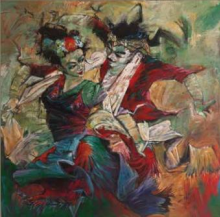
In some of the dancers' works in Zulfi's paintings are Jaipong dancers, Ketuk Tilu Dance, Mask Dance, and even dancers in Sundanese ritual events. As in the Figure 1. Entitled Ketuk Tilu, there are two dancers, a boy and a girl who are dancing together. As in the title of the painting, this dance is a typical West Javanese Ketuk Tilu dance. In general, the Ketuk Tilu dance is a paired dance. Ketuk Tilu dance is a traditional dance as an entertainment dance or social dance. This Tilu Ketuk dance was a dance during a traditional ceremony to welcome the rice harvest as an expression of gratitude to “Dewi Sri” (the goddess of rice in the belief of the Sundanese people).
As described by Zulfi, the costumes used in the Ketuk Tilu Dance show consist of male costumes and female costumes. In men's costumes, usually wearing kampret clothes with dark colors. At the bottom, wearing pants with attributes such as leather belts and machetes. On the head using a headband. For women's costumes, usually wearing kebaya clothes with sinjang pants at the bottom. Besides that, it is also equipped with accessories such as belts, scarves, bracelets, and necklaces. At the head of the dancer usually uses a bun decorated with flower arrangements to add to the beauty of the dancers.
In this painting, Zulfi describes as a tilu Ketuk dancer dancing with movements like the original. Zulfi did not change the essence and impression of the dancer much, he only tried to see how the beautiful body movements of the two dancers who were paired danced in harmony. The colors presented in the paintings tend to be bright colors, namely light green which dominates as the background. The cool color of the dancer's costume gives a calm impression and gives a relaxed feeling.
In its development, this Tilu Ketuk Dance has become an inspiration for artists in West Java. Although it was once a controversy because of its movements which were considered to be erotic, this dance has developed into the forerunner of popular dances in West Java.
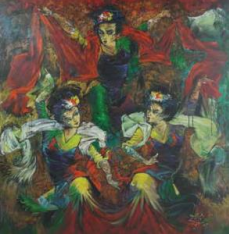
On the second artwork in Figure 2. entitled Selendang Merah made in 2020 is a painting by Zulfi featuring three Jaipong dancers. Jaipong dance is one of the most famous regional dances. This dance is a type of traditional dance originating from Bandung, West Java which was born from Sundanese culture.
Jaipongan contains erotic, humorous, uplifting, spontaneous and simpler movements. This can be seen from the presentation pattern during dance performances. This pattern is like the Ibing Pattern which is popular in the Bandung area, and the Ibing Saka which is not patterned and developed in the Subang and Karawang areas, and is called the kaleran style Jaipongan. The characteristics of this dance are very energetic and unique. In each performance will be accompanied by traditional music called degung.
As in the presentation of the dancer's object in Zulfi's painting, the three dancers look so elegant but still look energetic. The combination of colors that is presented tends to be hot colors, namely red, green and yellow which then gives the impression of being hot and close. The hot energy of this color is a symbol of the spirit of the character of the Jaipong dance. With the title 'Selendang Merah' it has been explained that the red color on the shawl is the main purpose as a message to be presented.
The background in this work tends to be dark with a combination of brown colors covered by the dancers. The color brown is one of the colors that contains the earth element. The dominance of these colors will give you a warm, comfortable and safe impression. Psychologically, the color brown will give the impression of being strong and reliable. This color symbolizes a foundation and life force. If it symbolizes conflict or an artist's unrest, it feels more precisely in describing their love for art, especially for traditional arts.
The Jaipong dance has also become an icon to introduce regional wealth, especially from cultural arts. This dance is not only popular among domestic people, because many foreign tourists are attracted by the uniqueness of this West Java mainstay dance.
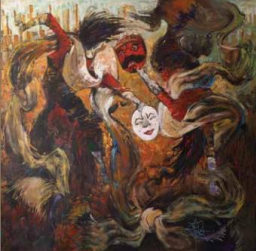
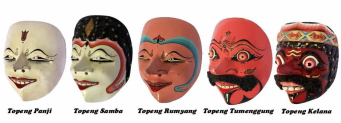
Different types of traditional dances in Indonesia are unique. These uniqueness can be in the form of movements, costumes, props, storylines, and the history of the creation of a dance. One of them is the Mask Dance, an original Indonesian dance originating from Cirebon, West Java. In Figure 3, Zulfi's work entitled 'Keseimbangan' which means ‘Balance’, it depicts two masked dancers from Cirebon. Mask Dance is a regional dance with the main characteristic of dancers wearing masks. Each mask used by the dancers has a different character and adds to the uniqueness of this cultural heritage. Mask dancers are called puppeteers because each dancer plays a different character. This dance can be performed by a dancer or in large numbers or groups.
Mask dance has certain meanings, philosophies and symbols, such as love, leadership, and wisdom. In the performance, these things will be conveyed to the audience so that they can be understood and can learn lessons from this dance. Thomas Stamford Raffles in his book The History of Java describes that Cirebon mask art is a description of the Panji story where in one mask art group consists of a dalang (who narrates the story) and six young people who perform it accompanied by four gamelan musicians (Raffles, 1817).
In Figure 4, is a type of mask that has a different character. Based on the type, Cirebon masks have 5 different characters and characteristics. Panji, whose face is pure white symbolizes the sanctity of a newborn, Samba (Pamindo), a child's mask with a cheerful, funny, and lively face, Rumyang, his face depicts a teenager, Patih (Tumenggung), this mask depicts an adult with a face. assertive, personable, and responsible, Kelana (Rahwana), a mask that depicts someone who is angry.
In Zulfi's painting, the dancer is depicted so dynamically. Two dancers in the painting are seen rotating in a circle. The dancer from the left faces upright, while the dancer's position on the right is against the direction with the head down. This illustrates the interpretation of the balance between top and bottom leading to a concept in Chinese philosophy that is usually used to describe the nature of the interconnected and opposing forces in this world and how they build on one another.
Like the symbols presented by the mask, namely Kelana and Panji, both of which have very different characters. Panji, whose face is pure white, symbolizes the sanctity of a newborn and the Kelana mask depicts someone who is angry. The two are opposites, such as good and bad, patience and anger. What's more, from the encouragement interpreted through the Cirebon Mask which means holiness and anger, but becomes a very complex concept for studying human life.
Ating Sudirman
Another artist who is consistent in working to paint presenting Sundanese traditional objects is Ating Sudirman who presents puppet characters in his painting objects. Ating Sudirman is an artist from Bandung who was born in 1965. Ating started working as an artist when he joined a painting group called Gerbong. Puppets used in the paintings are West Javanese wayang figures. It started because his daily life was in the environment of Sundanese art. Ating grew up in a family environment that is quite close to traditional arts. He grew up in a puppeteer environment who worked as a director in the art of wayang. However, his knowledge of wayang did not make him an art worker in the puppeteer or puppet world, he chose to become a painter.
Wayang in the sense of "Hyang", "God", "Spirit", or "Sukma" illustrates that wayang is a development of the ritual worship of the ancestors of the Indonesian nation in the past (Hazeu, 1979) Wayang is an imitation puppet made of leather or wood carvings and so on that can be used to portray characters in traditional drama performances. Wayang is very popular among Javanese, Sundanese and Balinese people.
Wayang in the sense of "shadows" illustrates that it contains paintings about various aspects of human life in relation to other humans, nature, and God, although in the literal sense wayang is a shadow produced by "wayang puppets" in performing arts (Darmoko, 1999). Wayang is usually played by someone who is called a dalang. Wayang Golek is a visualization result of the characters in the Mahabharata literary work. The form of Wayang Golek is usually adapted to temperament and some parts are adjusted to the special abilities possessed by characters in Mahabaharata literary works.
The influence of the environment was quite large on the paintings made by Ating Sudirman. In his work, he describes several Sundanese wayang characters such as Arjuna, Rahwana, Semar, Cepot, and others. In Ating's painting, his work is a painting with a flow of surrealism. The object that is presented gives a message to the public in the form of criticism of the government or the social environment.
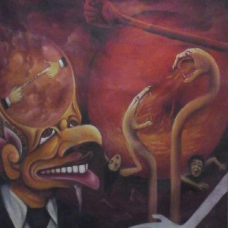
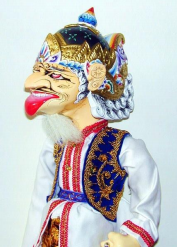
As in the title of the work in Figure 5, Dorna is one of the central figures in the mega story of the Mahabharata. Like in Figure 6, Dorna is depicted as a person with crooked eyes, a nose that may grow stubborn, like a worn whetstone. Mouth sills, chin wrinkles, will be a sign that the chin of an old man, bearded, bussed, hair in a bun, and clothes neatly shaped pastor. Hands can only be moved at the back. The other hand holds the prayer beads. Scan pants and shoes.
Dorna is arrogant, ruthless, talkative, but her skills, intelligence, and service are extraordinary and very good at war. Because of his supernatural powers and proficiency in soldiering. Dorna was born into a Brahmin family. He was the son of the priest Bharadwaja, born in the city which is now called Dehradun, which means that he developed not in the womb, but outside the human body, that is, in a barrel or urn. During his youth, Dorna was known as Bambang Kumbayana, with a powerful and powerful character.
In Ating's work, the figure of Dorna is like describing an incident in a hot socio-political situation. The colors in the painting seem dark, as if they suggest a mess. This hot issue may be the result of certain groups rolling out issues or conflicts that are deliberately created to divide into camps. Described from a puppet character named Sangkuni from the story Mahabharata who often incited Duryudana at that time to continue to clash with the Pandavas. Judging from the object of the hand resembling a quarreling cobra, this is a sign of our society being burned by the sheep fighting conflict so that it is easier to be mobilized or led to become a pawn for the group. It can be implemented from a political perspective in previous years, such as in 2019 the splitting of several groups of people and issues that were always masterminded by several individuals to achieve a certain power, maybe this is the right figure for an event of civilization development through conflicts that continue to emerge.
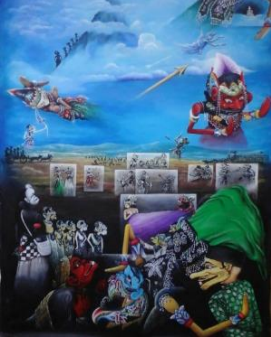
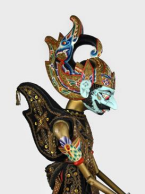
In figure 7, this work entitled 'Gatot Kaca Gugur Perang Bratayuda’, at a glance it can be seen that this painting conveys a war in puppetry, namely the war fought by Gatot Kaca. In Indonesia, Gatot Kaca is arguably one of the most recognized puppet characters. In Figure 8, is a figure of gatot Kaca, this character has no wings but can fly, blue faced, and has extraordinary strength. Therefore, Gatot Kaca often gets the nickname 'muscle wire, iron bone' in the wayang world.
In the puppet story, the end of life for Gatot Kaca is quite ironic, because this one puppet character was shot dead by a Konta Wijaya gun in the navel. In fact, previously the sarong from Konta Wijaya's heirloom had saved Gatot Kaca by successfully cutting his umbilical cord. However, this also means that Gatot Kaca can only be injured or killed because of this heirloom. Gatot Kaca's death occurred during the Barathayuda war when he tried to fly as high as he could to avoid the Konta Wijaya heirloom used by Karna. Even so, Gatot Kaca still managed to kill many of the Kauravas when he fell with tremendous force to Earth.
'Gatot Kaca Revolusi Bratayuda' is the title of this work which briefly explains the situation of the painting. The situations described in Ating's work in figure 7, endured quite a number of conflicts that occurred there. In this description there are several battle scenes in small squares. It can be described from a very famous battlefield in Kurushetra where the Mahabharata war took place. However, in this situation, it seemed as if the war had ended because of the death of Gatot Kaca at that time.
It is said that the death of Gatot Kaca had been arranged by King Kresna. King Kresna wanted a perfect victory for the Pandavas in the Bharatayudha war. He was afraid of Karna's mainstay arrow called Kunta, which is a very powerful weapon, there is no weapon that is greater than Kunta. Karna's plan to use Kunta's Arrow against Arjuna. But seeing Gatot Kaca so mighty destroy Kurawa troops. Kurawa's party was desperate and asked Karna to kill Gatot Kaca and Gatot Kaca to die by Kunta's arrows. He fell from the sky and crushed the earth.
As we see warfare on television or hear tales of warfare from a narrator who is quiteemotionally draining, Ating hereby tries to convey a war story in the world of wayang through a painting. In the war presented in the painting, Semar, Cepot, Dewala, Pandawa (Arjuna, Nakula, Sadewa, Bima, and Bisma), and Kurawa (Duryudana, Dursasana, Ugrasena, and Citareksa) saw the death of Gatot Kaca. Maybe if you hear the original fairy tale, it seems that not all of them were present at the event. However, in this painting, everyone looks so busy and is present as a witness to the death of Gatot Kaca in the Bratayuda war as a symbol of deep sadness for all the people in the puppet country.
Conclusion
Traditional painting cannot be separated from the activities of community life. Art is part of spiritual expression and spiritual expression always presents art. In fact, painting has undergone many developments. Painting with the theme of traditional art contains philosophical, spiritual, social, economic and cultural values.
Through a painting by Zulfi Akmansyah and Ating Sudirman, they are trying to rebuild people's awareness of the value and love of Sundanese tradition. In Zulfi's work, he presents the traditional Sundanese dance arts, namely Jipong, Cirebon Mask, and Ketuk Tilu. From this work, Zulfi interprets traditional arts by taking the movements of the dancers as visuals he sees from his experience watching Sundanese dance performances and his interest in the beauty of the Ketuk Tilu dance movements. Meanwhile, the puppet presented by Ating Sudirman is a representation of the Sundanese Wayang Golek figure. He tries to convey wayang stories through his work by presenting stories and figures with strong characters. In addition, Ating's work tends to have a moral message towards society, such as in the work entitled Dorna, which criticizes the government in Indonesia in 2019.
Artists often have separate roles in society, but through networks and the environment can shape themselves. The networks that are formed are often part of community activities, from exhibitions, public discussions, workshops, and so on. This real role as a society then makes artists like Zulfi Akmansyah and Ating Sudirman play an important role in cultural change, especially in Sundanese culture.
References
Coates, E. (2017). The Poetics of Physics in Dance. PAJ: A Journal of Performance and Art, 39(2), 7-21.
Creswell, J. W. (1994). Research Design: Qualitative and Quantitative Approaches. Sage Publication.
Darmoko. (1999). Wayang: Bentuk Isi Dan Nilainya [Puppets: Forms, Contents and Values]. Fakultas Sastra, University of Indonesia.
Hazeu, G. A. J. (1979). Kawruh Asalipun Ringgit Sarta Gegepokan Ipun Kaliyan Agami Ing Jaman Kina. [Kawruh Asalipun Ringgit and Gepokan Ipun Kaliyan Agami Ing Kina era. Ministry of Education and Culture, Project for Publishing Indonesian and Regional Literature and Literature Books]. Departemen Pendidikan dan Kebudayaan, Proyek Penerbitan Buku Bacaan dan Sastra Indonesia dan Daerah.
Himawan, W. (2013). Visual Tradisi dalam Karya Seni Lukis Kontemporer Sebagai Wujud Artistik Pengaruh Sosial Budaya. Ornamen, 10(1).
Murgiuanto, S. (1993). Moving between unity and diversity: Indonesian dance in a changing perspective. TDR (1988-), 37(2), 131-160.
Raffles, T. S. (1817). The History of Java. The Monthly Magazine, 43(300), 598-622.
Rohidi, T. R. (2000). Kesenian Dalam Pendekatan Kebudayaan. [Art in Cultural Approach]. STSI Press.
Shils, E. (1981). Tradition. University of Chicago Press.
Stake, R. E., Denzin, N. K., & Lincoln, Y. S. (1994). Handbook of qualitative research. NK Denzin & YS Lincoln (Eds.), 244.
Types of Cirebon Mask. (2021). cirebonkota.go.id
Wayang Golek Gatot Kaca. (2021). wayang.wordpress.com
Wayang Golek Dorna. (2021). wayang.files.wordpress.com
Yudoseputro, W. (2008). Jejak-JejakTradisi Bahasa Rupa Indonesia Lama [Traditions of the Old Indonesian Visual Language]. Yayasan Seni Visual Indonesia.
Copyright information

This work is licensed under a Creative Commons Attribution-NonCommercial-NoDerivatives 4.0 International License.
About this article
Publication Date
31 January 2022
Article Doi
eBook ISBN
978-1-80296-122-5
Publisher
European Publisher
Volume
123
Print ISBN (optional)
-
Edition Number
1st Edition
Pages
1-494
Subjects
Communication, Media, Disruptive Era, Digital Era, Media Technology
Cite this article as:
Sadono, S., & Pebrianti, P. (2022). Visual Interpretation of Painting Themed of Sundanese Traditional Arts in Bandung. In J. A. Wahab, H. Mustafa, & N. Ismail (Eds.), Rethinking Communication and Media Studies in the Disruptive Era, vol 123. European Proceedings of Social and Behavioural Sciences (pp. 168-180). European Publisher. https://doi.org/10.15405/epsbs.2022.01.02.14

